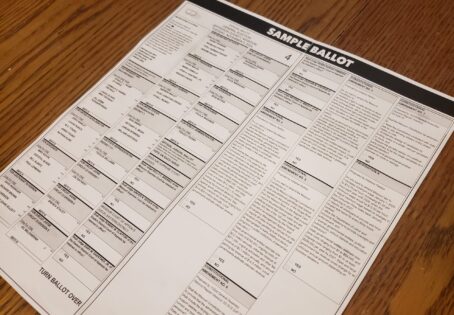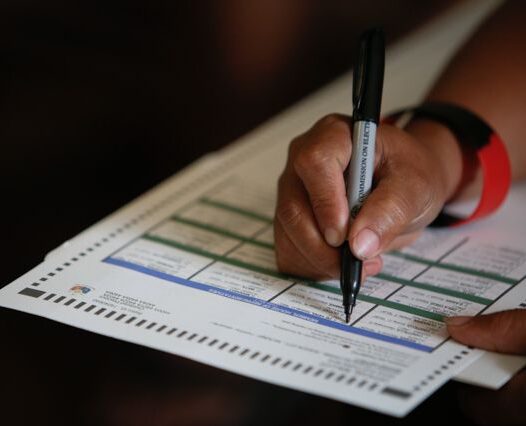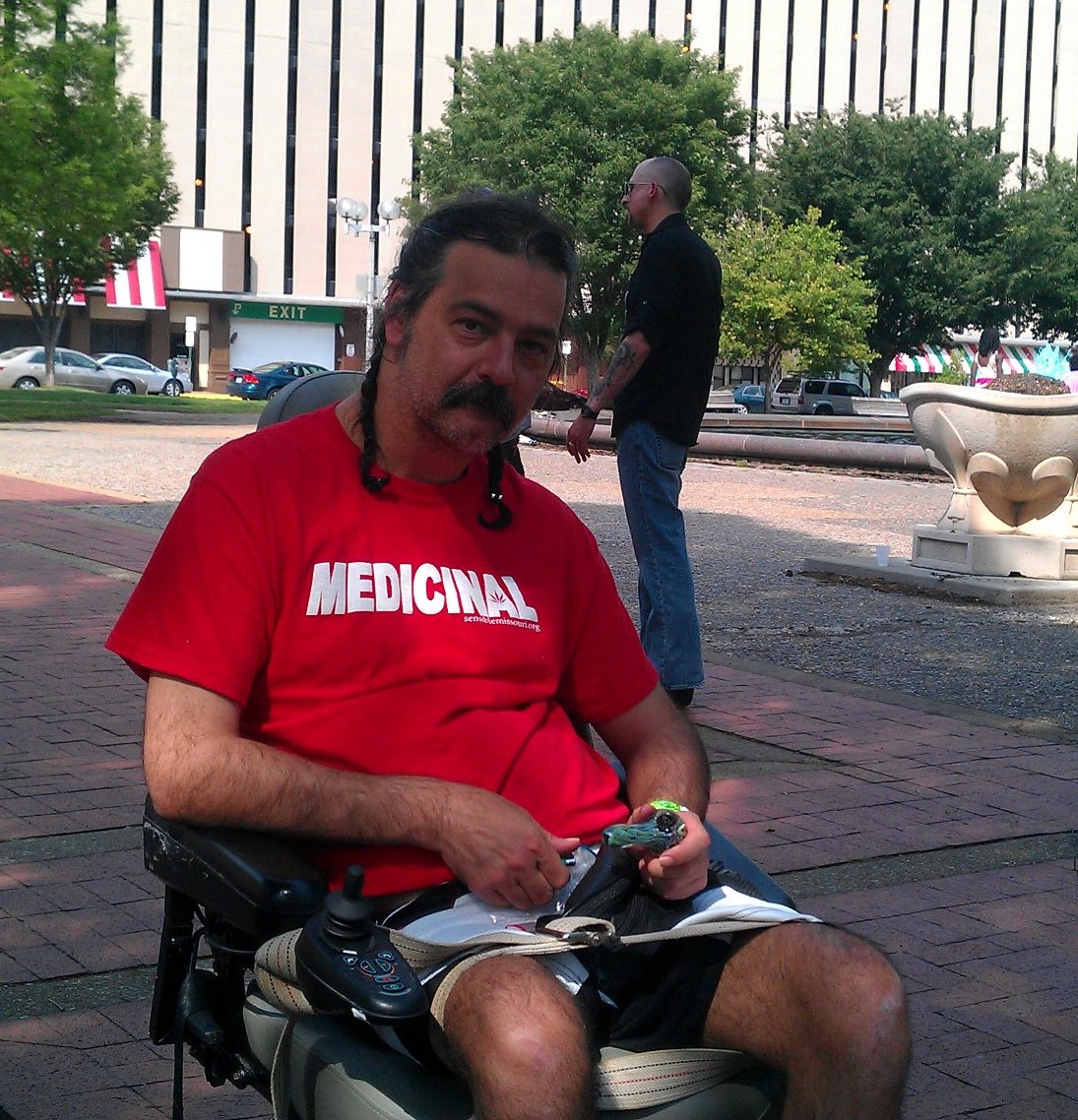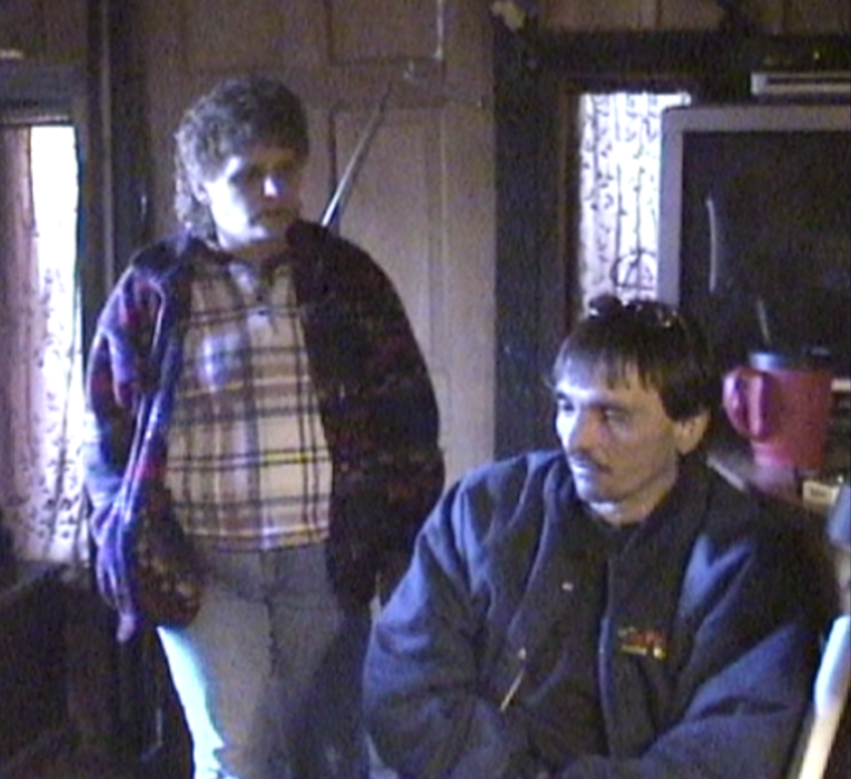My Interview with Jack Quinn
By Mark D. Pedersen
In 2013, my former business partner, Regina Nelson and I had CPN Institute, an educational org. Our most benevolent Colorado sponsor was RiverRock Wellness of Denver. It was through their sponsorship that we were able to be the first Cannabis organization to have a booth at the Colorado State Fair… actually, the first at ANY state fair anywhere in the country at the time. Their financial support was crucial to much of the work we were doing back then.
It was through our relationship with them that I came to know Jack Quinn. RiverRock sponsored Jack, providing his meds as a special case because of his limited income and the severity of his condition.
Jack had basal cell carcinoma. A scourge that he had suffered for much of his adult life.
Jack, a gentle, gray haired man, was in his 70’s at the time of our interview. His quiet self assurance was honed from a life of overcoming obstacles, perseverance and dedication. He, his wife, Phyllis and their son Jason worked hard to create a life for themselves in Colorado.
Over the course of the year prior to our interview, I monitored Jack’s treatments from RiverRock and his remarkable progress. Because Jack’s Cannabis medications were provided free or at a discounted rate, he was able to take full advantage of the very best that RiverRock had to offer. No doubt, Jack’s remarkable response to treatment was because of the exceptional attention he was getting.
I found out much later that RiverRock had a tenuous reputation with the Colorado Cannabis community over what was rumored as “aggressive” business practices. There was little doubt that our sponsorship, as well as our regular public critiques of RiverRock products went a long way toward healing the rift… and it sold inventory… a lot of inventory. No doubt we had been brought on to help curb the negativity.
Apparently, so too was Jack’s involvement. Videos spotlighting Jack’s medicine and weekly progress were constantly in the public eye. Of course, his remission was unmistakable. It didn’t matter that the monthly cost for all that Jack was taking was prohibitive for most Coloradoans. His lesions were rapidly healing. What we were witnessing had tremendous potential for everyone battling skin cancers.
Jack appeared to be having a steady recovery, but as time passed, Something seemed amiss. I received word that Jack was having trouble getting his medication. All or part of his weekly treatments were coming up short. What’s worse, his basal cell was returning and he was once again under the surgeon’s knife.
But why? RiverRock’s products were directly responsible for healing Jack of skin cancer. That’s no small thing. Why was Jack’s Cannabis medications no longer in easy access?
We know that, early on, he was popular, and that was profitable for RiverRock and other dispensaries that benefited from what was, for all purposes, a miracle, displayed in photos and video for all to see.
But as time progressed, Jack’s story slowly succumbed to newer, flashier ads. “Recreational” products had a much more immediate return. “Dabs” had become all the rage. Dispensaries, particularly higher profile dispensaries like RiverRock were in competition with each other to perfect the very best recreational concentrates. Medicinal products just didn’t have the same revenue draw. But of course, that’s only my assumption.
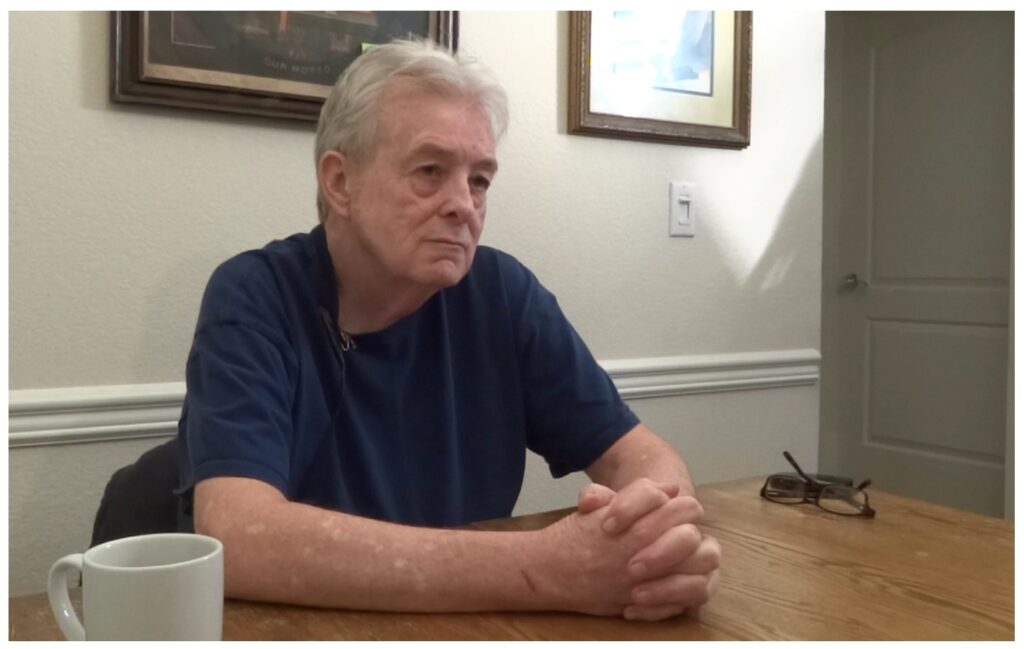
Jack was seemingly disappearing into obscurity and his cancer was returning with a vengeance. I couldn’t let that happen without doing something. So I asked him to sit for an interview, to tell his story.
The interview
It was a clear day in 2014 when Jack came to my apartment for his interview. I had cameras, lights and sound waiting. Sitting down at my dining room table, we began…
Jack: “I’m just gonna follow your lead at first here. Then as a typical Irishman, I can talk. There’ll probably come a time when you’ll want to stop me.” (Jack chuckles)
Mark: (Smiling, I began by asking), “Your name, please, and where you’re from…?”
Jack: “This is Jack Quinn. John T. is my legal name. Jack is what I go by. I’m from Thornton, Colorado, which is just north of Denver, Colorado. I’ve lived in here now for about forty years. Before that, I lived on the east coast.”
Mark: “Oh wow. I didn’t know that about you, Jack.”
Jack: “Born in the Bronx. Lived in New Jersey from when I was seven.”
During those early years, Jack’s family was splintered by a tragedy when a serial killer took his sister’s life. She was loosely depicted in the 70’s movie, “Looking for Mr. Goodbar”. Jack’s family had to sue to keep their name out of the movie. It wasn’t long after that he made the decision to make a fresh start in Colorado.
Jack: “I was twenty-six when we moved to Colorado. I’m 66 now, so I’ve been here a while… 40 years!”
Mark: “Tell me about your illnesses.”
Jack: “You know, I’m a person who smoked marijuana in my youth – on and off through oddball years, I would start and stop depending on the jobs I had. There were jobs where it would be best NOT to consume, but as soon as I retired, I was looking for relief… mostly from nerve damage. Cannabis helps me with sleeping and spasming.”
Mark: “How did this nerve damage come about?”
Jack: “I have two hip replacements. My first hip replacement wasn’t the greatest operation. I wound up with bad internal bleeding. They stretched my trunk nerves too far. So my sciatica and peroneal nerves are damaged. I have terrible pain in my right foot that won’t go away. It goes up into my leg a bit, but it’s concentrated in my foot around my big toe. Eventually, I had to go on morphine for this. I could hardly walk. I certainly wasn’t sleeping.”

Jack asked a friend if he knew where he could get some Cannabis. Obtaining it, he took it home and quietly smoked. That afternoon, he fell asleep in a chair for the first time in a while. His nerve damage was significant, but between smoking and edibles, he had relief.
The Skin Cancer
Jack: “I spent my summers as a kid at the sea shore in Rockaway beach, Long Island, where my parents would rent a bungalow for the summer. Later as a teenager, I was a lifeguard at Lake Silver Springs in New Jersey.
These were “pre-sunscreen”, ‘pre-SPF factor’ years. We would complicate things by using baby oil and iodine.”
During the mid-twentieth century, long before the harm from sun exposure was really widely understood, the use of baby oil and iodine as a sun tan lotion was a common practice. They would pick up a bottle of Johnson’s Baby Oil, dribble a few drops of iodine into it and shake it up. It wasn’t sunscreen, by any stretch of the imagination. In fact, the mixture would actually work as a reflector, intensifying the UV rays and allowing the harm to penetrate deeper, compromising sensitive skin tissue and causing serious permanent damage.
Jack: “I had a lump under my left eye. It had been there for quite a while. Didn’t seem to be anything special. Just a small round lump. Six months or so before moving to Colorado, I had noticed it was growing. So I went to my eye doctor. Removing the lump was just a routine in-office excision. A week later, I received a phone call. The biopsy revealed that it was ‘basal cell’ cancer.”
Jack knew nothing about skin cancer back then. The very thought that he had cancer frightened him. All he could think was that he was going to die quite terribly. So he began researching skin cancers. Fortunately, he found that basal cell was rarely fatal.
Basal cell carcinoma is the most common form of skin cancer. Cancerous cells develop within the basal cell layer of the skin, or the lowest part of the epidermis. Basal cell cancers usually grow slowly, and it is rare for them to spread, or metastasize to nearby lymph nodes or other parts of the body.
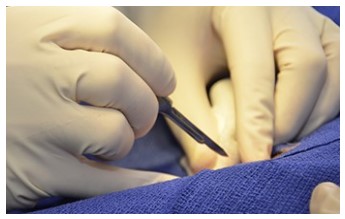
In the years that followed, his trips to the “skin doctor” were at first occasional, but as time progressed, the trips became more and more frequent. He eventually found himself in the doctor’s office every three months, having four to six spots excised. Then another ten to twenty spots frozen by liquid nitrogen. Jack endured this for years leading up to this interview.
Around this time, Jack learned that his nephew had been diagnosed with Esophageal cancer. Jack had read of successes treating various cancers with Cannabis oil, so he thought, if only he could demonstrate some effectiveness in treating his basal cell, perhaps he could convince his nephew to try it as well.
Unfortunately, Jack’s nephew lived in a non-legal state and without even a basic understanding of the true nature of Cannabis. He had a fear of euphoria and wasn’t receptive. He passed under conventional care.
Jack: “I was actually looking for a FECO (Full Extract Cannabis Oil) type program when I met the gentleman who ran RiverRock Wellness. He said he had something better. Which turned out to be CBDs. So,I started a high cbd program. Within two months, my skin cancer cleared up very well. By three months it cleared up almost completely.”
When Jack went to his next skin doctor visit, the physician couldn’t find anything to excise . Nor could he find anything to burn off with liquid nitrogen – something that had become the norm for every visit prior.
At that point, the doctor insisted that Jack strip to his “boxers” shorts. Still, he could not find any spots – even after a thorough search.
Jack went another six months, trying to stay on the cbd program as much as he could, but there appeared to be a problem with supplies.
Jack: “Eventually, a couple of things happened. My skin cancer came back, as I was no longer doing the complete CBD program, and my income was cut by a third. I tried some topicals, but very little seems to be helping at this point. I’d like to get back to doing a program that actually helps.”
It was then that I asked Jack if he could show me any current lesions.
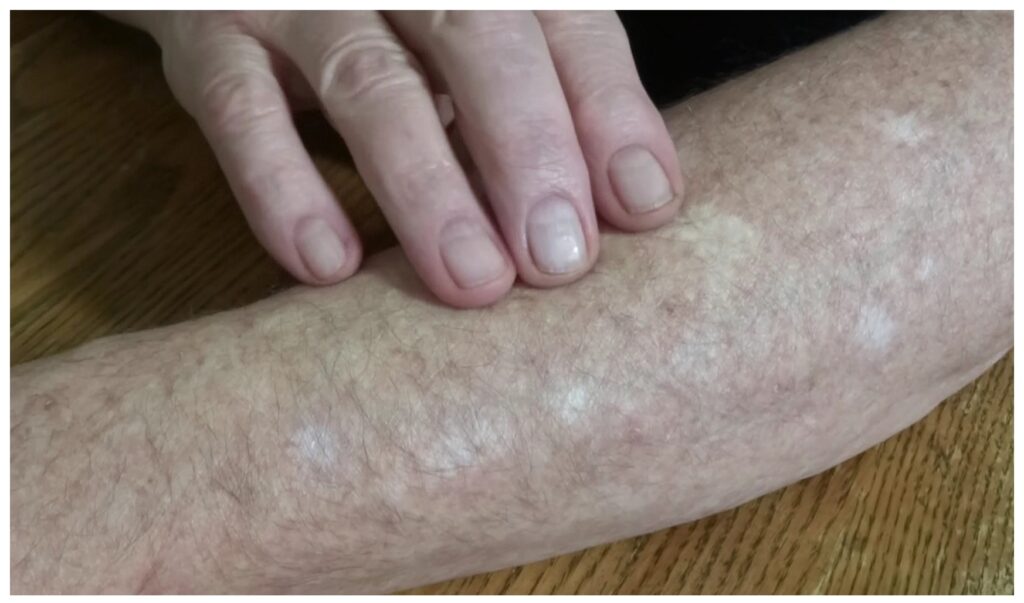
I continued photographing Jack’s scars, panning up on the right side of his neck.
Jack: “Seeing some of the scars on my neck? (Jack pulls down on his collar and tilts his head, pointing and rubbing a scar in front of his right ear) This is a recent, hopefully healed spot…from the cancer. . I had four spots removed in December that were cancer. This is one of the four spots. It’s now healed up.
(Pointing to a spot on his forearm) “That little red spot there is an emerging skin cancer. I can tell because I’ve been following it. Also it’s getting a little flakiness on the top. It started out as a little pink spot, then it got a little bit bigger and wouldn’t go away. Eventually, it became kinda rectangular and started getting a little rough spot on it. Yeah, that’s an emerging skin cancer right there. On the rest of my arm, there are more spots. A few ran together there, (moving a pointing finger across his arm) that’s two or three little spots that came together.”
Jack pulls up his left sleeve, revealing the site of his second skin cancer – and one of his biggest.
Jack had ignored it for too long. His personal doctor had told him that it wasn’t cancer. So he didn’t send Jack to a skin doctor until it was really late. He kept telling him that it was Actinic Keratosis, which is scar tissue caused by exposure to the sun. But what they weren’t realizing was that Jack’s Actinic Keratosis was mutating into cancerous cells.
When he finally did get to a skin doctor, he pressed Jack to remove it immediately.
Actinic Keratosis happens when ultraviolet light strikes unprotected skin, changing one’s DNA on a cellular level. This affects the dermis, the deepest layer of the skin. It can be years before the damage becomes visible.
Jack: (running his right index finger back and forth across his left forearm), I have a spot right here that’s broke out in the past. Unfortunately, right now I can feel bumps but you really can’t see much in the way of breakouts. I could show you where I just had four removed.”
Jack begins tugging at his shirt, pulling it up to show me a wound on the upper left part of his chest. Across his chest were a multitude of white scars exploding amid pink freckled skin. Jack points to one particular scar.
Mark: “How long have you been having these removed?”
Jack: “Since 1974. That was the first one. Forty some odd years. Here is one on my shoulder (Jack reaches back over his right shoulder). Can you see a bigger scar there? That’s a culmination of four or five cancers that I had removed in December. They have grown into one big scar (circling the scar with his index finger). Seems that area keeps growing more basal cells.”
Jack turns in his chair revealing the scars on his back, as he tilts his head and pulls back the hair behind his left ear.
Jack takes off his shirt, revealing hundreds of white scars, covering virtually every part of his body.
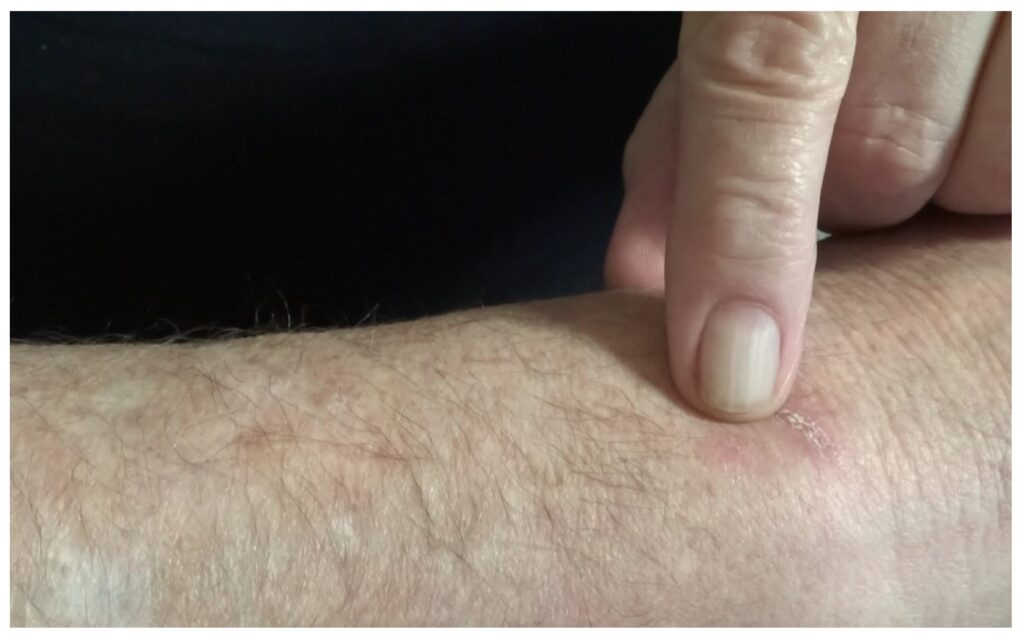
Jack: “I have scars in the middle of my back. I’ve also had a number of what is called Mhos Surgeries… (he grasps his surgically deformed left ear). Two years ago, I had Mhos Surgery on this ear. They kept going all that day til they got a clear spot. It took six and a half hours to do this ear with seven different excisions before it was done,”
Mhos Surgery is a microscopically controlled surgery used to treat both common and rare types of skin cancer. During this surgery, after each removal of tissue and while the patient waits, the tissue is examined for cancer cells. That examination dictates the decision for additional tissue removal. Mhos surgery is the gold standard method for obtaining complete margin control during removal of a skin cancer.
The top half of Jack’s ear was gone, so they had to reconstruct it, leaving a notch in his ear. For two years now, he has had inflamed cartilage that has required regular shots to deal with the inflammation. It’s not cancer, but it’s a chronic problem resulting from this type of surgery.
Jack: “I have my fair share of scars. scars on my back, my shins, my feet, my thighs, . I have ’em on the back of my calves – didn’t get much sun there, … I’ve got six or seven cancers that were on my right ankle where I was hit hard by a softball. I asked the doctor how that was possible. He said any damaged tissue can get cancer, particularly if you’re prone to skin cancers.”
Mark: “Interesting. I’ve never heard that.”
To date, Jack has had over
300 excisions, and approximately 3000 liquid nitrogen burns.
You could literally look anywhere on his body and see an amazing amount of scarring. He pointed to a recurring spot on his shoulder where a half a dozen smaller spots had come together.
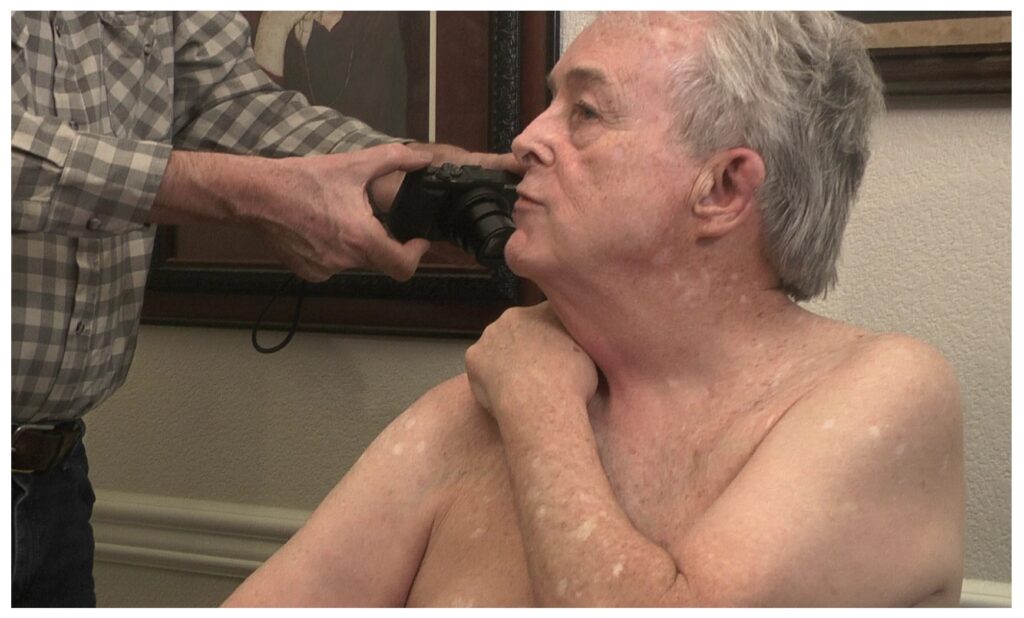
In the last ten years, he has had a number of squamous cell carcinomas begin to appear. They develop a bit deeper than the basal cell.
I move in with one of my cameras for a closeup.
Mark: “You’ve gone a long time having lesions removed…a lot of scarring, a lot of pain. You’ve had both basal cell and squamous cell carcinomas removed. Can you explain the difference?”
Jack: “Basal Cell, though reoccurring, doesn’t penetrate as deeply as Squamous cell, and so it’s not as likely to spread to other parts of your body …the liver, the lymph nodes. Most squamous cell are like the basal cell in that if you remove them as soon as you find them, there’s less chance of complications.”
Squamous cell carcinoma is the second most common type of skin cancer. Cancerous cells develop from the flat, squamous cells that are the primary type of cells making up the outermost layer of the skin, the epidermis. Squamous cell cancers usually grow slowly, and it is uncommon for them to spread, or metastasize, but they are more likely than basal cell carcinomas to invade fatty tissue beneath the skin or to spread even further.
Financial Constraints
Mark: “Your biggest challenge has been financial, hasn’t it?”
Jack: “At this point, definitely. You can live – going every three months – getting spots cut off. And, if you have insurance (Medicare for the marginalized), they don’t charge you much usually. I couldn’t imagine what I would do if I didn’t have insurance. But of course, I live with open sores and scabs… itchy, painful spots perpetually breaking out on my body. As soon as one heals up, I’m back in the doctor’s office for more excisions. So finding a cure would be ideal to keep this from happening any more. It’s just one of multiple conditions that I have, but this, if it were financially possible, would be the easiest to address.”
Mark: “It’s heartbreaking, though. Cause you’ve already experienced what it’s like to no longer be cut on anymore. And now you’re having to go back to that.”
Jack: “Yeah. My skin doctor was kinda chuckling when I went to see him. I had forced him into researching Cannabis oil therapy. He’s a believer, now, but it’s cost prohibitive. He said I could come to his office every three months for $35… a $140 per year…and have them cut out, or, I could go back on the (Cannabis) program I was on which costs over $400 per month.
Mark: “WHO, on a fixed income, can afford that?”
Jack: “It would be lovely if it were covered by insurance. But that day is a long way off yet. We would need to remove it from it”s Federal classification. And we need to get all of the insurance companies onboard. But they’re dragging their feet because they know it’s gonna cost them money. They would save people money in the long run.”
Mark: “Dispensaries don’t seem to understand that, for the majority of the chronically and terminally ill, it’s a struggle to afford their medication. You can’t afford to spend $200 on Cannabis…not with all your other expenses. Let alone the thought of $500..or more! What a situation to put a patient in. I never thought I would be seeing this here in Colorado.”
I recall being invited to a home in North St. Louis. The wife of the gentleman I met with was dying of brain cancer. The whole time while we were talking in the kitchen regarding Cannabis oil, how it could benefit his wife, she was wailing at the top of her lungs from the other room. She was out of her head with pain…and in the latter stages of her cancer.
I sat there and explained to the husband how Cannabis oil could possibly extend her life… but he would never be able to afford it ..or even have access… because it was illegal.
He had to watch his wife die. I thought that was so very unconscionable.
And, here I was again, sitting across the table from a patient who couldn’t afford his medicine…but this time, I was in Colorado, where it was “legal”.
Jack: “I think everyone thought that once Colorado went legal it would just be like, WOW, look! We’ll all have access! But instead, all the dispensaries jacked up their prices incredibly for their retail customers. That affected the price of medical, and what was available.”
Mark: “There’s a thriving black market. It’s amazing… the price for Cannabis is actually cheaper in St. Louis right now than it is here (at the time, Cannabis was still illegal in Missouri).
Jack: (chuckling) “Surprising.”
Mark: “I imagine a lot of people in this country don’t realize what life is like for a Cannabis patient in this state. The more Colorado patients that I talk to, the more I find…they just can’t afford it. That amazes me. Cause at the same time, I realize that there are literally millions of people outside our bubble who are just now beginning to hear about it.”
A Maintenance program
Jack: “I wound up on the cbd program because that was what was available to me. But, I was curious. I was never told about an “end”. I just presumed, like oil programs for other cancers, that I would do a massive amount of oil at first, then, I would settle into a maintenance level. I was never able to find that maintenance level with CBD.”
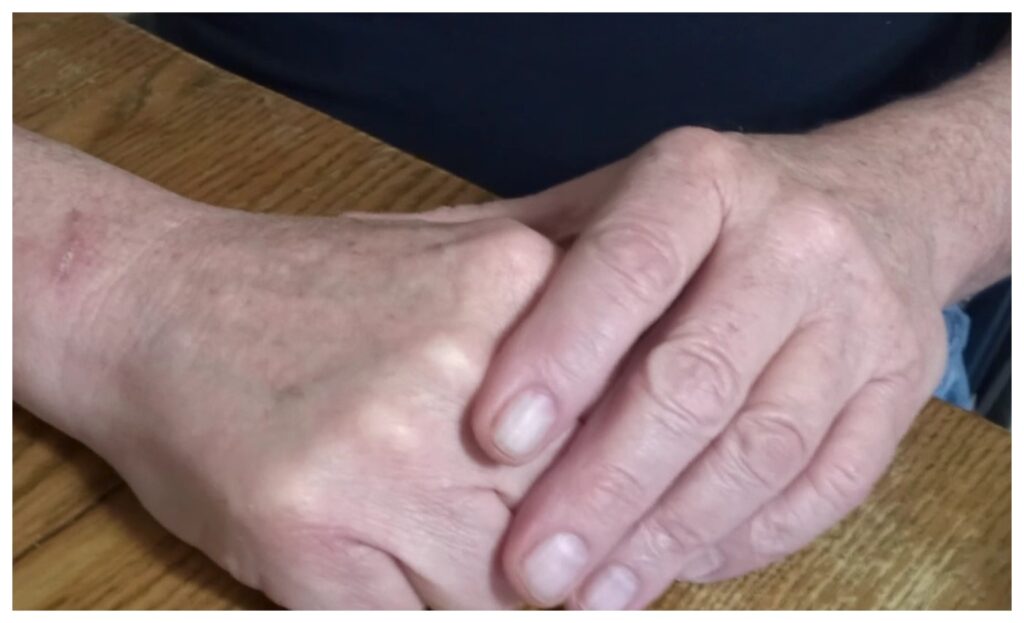
Mark: “Really? What do you mean by ‘never found a maintenance level’?”
Jack: “Maybe if I could have stayed on the full program longer, but, after about 3 ½ months, the dispensary was already having trouble keeping up with the oil and other products. Within a couple of months, I had spots appearing again.
Every time I was in the dispensary, I would tell the manager, ‘Get me oil, get me oil! Get Jack oil!’ (Jack chuckles) But you can’t get blood from a rock. If they didn’t have it, they couldn’t give it to me. Finally when they started getting stock back in, they wanted me to go on an even more expensive program than before. And I would have to pay for it, even though the manager had known for a year that I would be losing income. I don’t understand why things changed.
It just all seemed unfinished. I wasn’t on the program long enough (for a cure). I was only on the program long enough for my skin to clear. I didn’t quit the program. They ran out of product and the lesions came back.”
Mark: “Did you encounter any side effects or problems while you were on the full program?”
Jack: “No I didn’t have any problems whatsoever. It was pretty effective, but it was involved. I had different things to take all day, every day …forever.”
Mark: “Are you on any special medications?”
Jack: “I’m on Lisinopril. I’m on a maximum dose of that.”
Lisinopril is an ACE inhibitor, designed to treat high blood pressure and heart failure. It can also reduce the risk of death after a heart attack.
Mark: “How did being on the CBD program affect the prescription drugs you were taking?”
Jack: “That’s the conundrum that I am still dealing with. I cut back on my narcotics, but I don’t know if that was good for me. My kidneys have been slowly getting worse since 2008 according to the lab tests, but just recently, they have gotten quite worse.”
When Jack was doing a high CBD program, his dispensary “mentor” told him that he could cut back on his narcotics. That made sense to Jack since Cannabis was reducing his pain levels. Then they would be accomplishing two things at once – healing his skin cancer AND reducing his dependence on narcotics.
Jack had been taking Morphine and also Percocet for breakthrough pain.
His “mentor” hadn’t taken into account that Jack had high blood pressure and compromised kidneys. When Jack cut back on his narcotics, his blood pressure went up, adversely affecting his kidneys. This all came very close to going very bad for Jack.
Mark: “I don’t really think people realize that when you’re taking a Cannabinoid therapy that it’s replacing serious, prescription drugs that are straddling the line of toxicity in order to conventionally control the symptoms of pain and disease. That’s why it’s so very important to have a consistent, never-ending supply of whatever is replacing them.”
Jack: “Yes it is. I didn’t take it all into account. Even now, I’m really not sure if RiverRock’s budtenders know about my kidney situation.”
Mark: “How are your kidneys now?”
Jack: “I think they are steadily declining. I will be going for a kidney biopsy soon. It’s been scheduled. They may change up medications or treatment then.
Mark: (As Jack puts his shirt back on, we both let out an exhausted sigh…) “I think that is sufficient. I’m gonna turn these cameras off and I think we’re gonna do some Cannabis.”
Jack: “Sure!”
Mark: “I think we’ve earned it, Jack. Thank you, sir.”
* * *
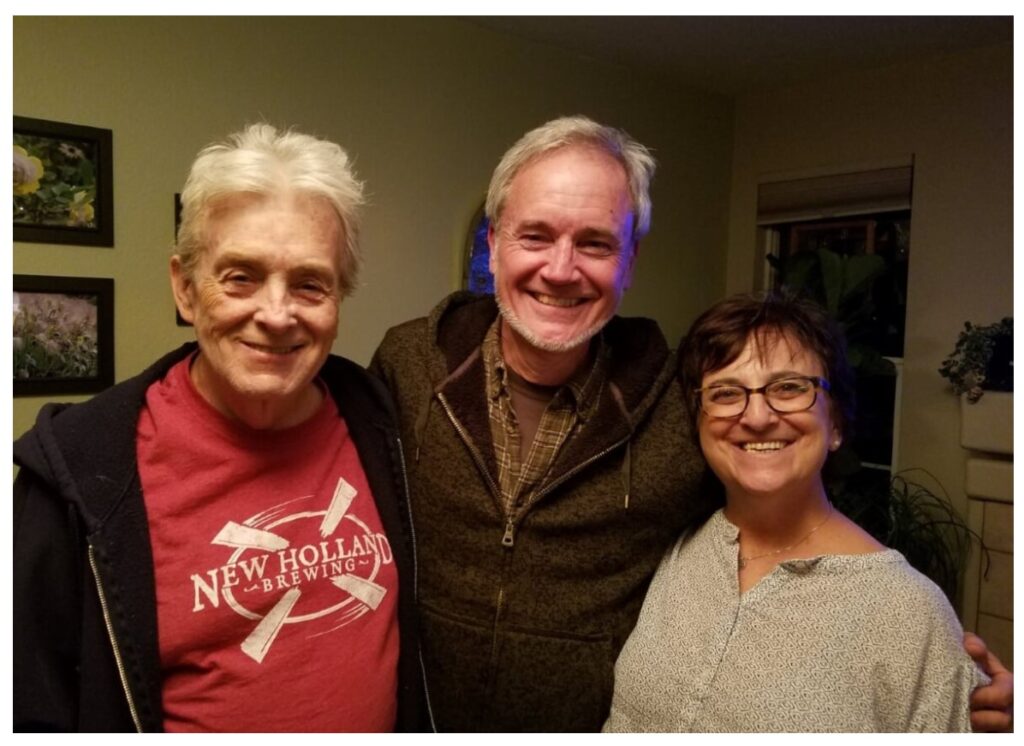
In Summary
After Jack’s video went public on YouTube, he began receiving his medicine again. And, coincidentally, most of our sponsoring dispensaries canceled their support.
After about six months, Jack was once again having to pay full price for his meds, so I provided him with trim oil for a year or two leading up to my arrest. He never again achieved complete remission.
What could we learn from all of this? Well, of course, patients truly need their medicine – whether pharmaceutical or Cannabis, And, they REQUIRE a continuous, uninterrupted supply. We’re dealing with people’s lives here. They are, particularly in cases like this, putting their lives in our hands.
Cannabis patients are real people, and so are their ailments. . Dispensaries need to have some legitimate medical training before asking the chronically ill to titrate their pharmaceuticals. Their lives truly could hang in the balance.
Cannabis is nontoxic. Cannabis is food. Cannabis is the single most important medicine of the 21st century.
https://mominformed.com/can-i-use-baby-oil-and-iodine-for-tanning
https://www.yalemedicine.org/conditions/sun-damage#:~:text=Dermatologists%20refer%20to%20the%20damage,solar%20damage%2C%20or%20sun%20damage


